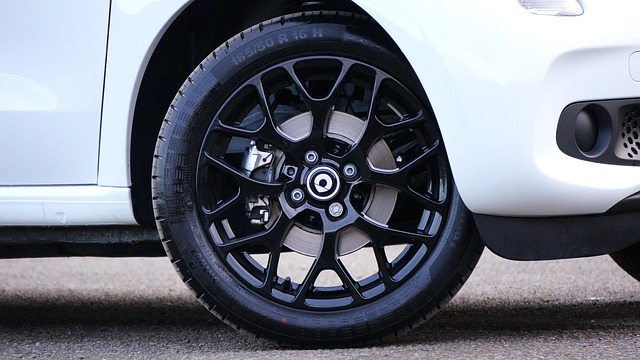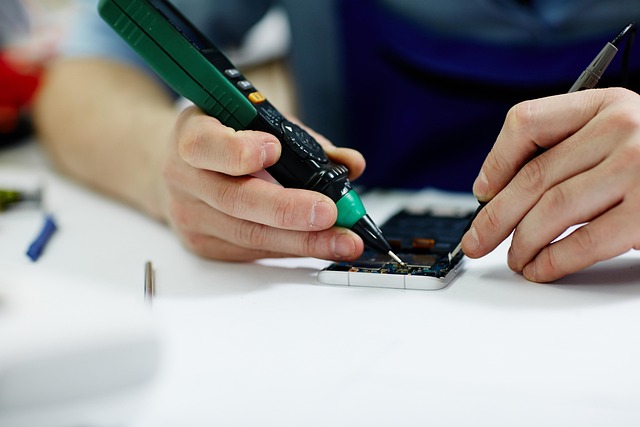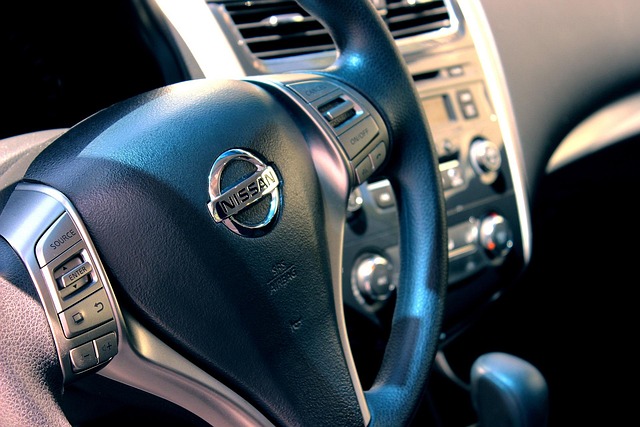Mastering Commercial Vehicle Repair: Essential Tools for Efficient Repairs
Commercial vehicle repair requires specialized skills and a well-equipped workshop to handle complex…….
Welcome to an extensive guide on commercial vehicle repair, a critical aspect of the global transportation industry. This article aims to take you on a comprehensive journey through the world of repairing and maintaining commercial vehicles, from its historical roots to cutting-edge technologies and future prospects. By the end, readers will gain a deep understanding of this dynamic field, its economic impact, and the challenges it faces. Get ready to explore how commercial vehicle repair is not just about fixing machines but also driving efficiency, safety, and sustainability in our modern world.
Definition: Commercial vehicle repair refers to the specialized maintenance, servicing, and restoration of vehicles designed for business or commercial purposes. These vehicles range from trucks and vans used for cargo transport to buses ferrying passengers and specialized equipment like firetrucks and forklifts. The scope includes not just mechanical repairs but also body work, electrical systems, and technology upgrades.
Core Components:
Historical Context: Commercial vehicle repair has evolved alongside advancements in transportation technology. From the early days of horse-drawn carriages to modern electric and autonomous vehicles, the industry has adapted to changing demands. Post-World War II saw a boom in truck manufacturing, leading to specialized repair shops catering to these new commercial fleets. Over time, as vehicles became more complex, so did the repair processes, incorporating electronic diagnostics and advanced materials.
Significance: This sector plays a vital role in ensuring the smooth operation of businesses reliant on their vehicle fleets. Well-maintained commercial vehicles improve efficiency, reduce downtime, and enhance safety on our roads. Moreover, it contributes significantly to:
The reach of commercial vehicle repair extends far beyond national borders, with significant global implications. Here’s a glimpse into its international landscape:
| Region | Key Trends | Unique Challenges |
|---|---|---|
| North America | – Dominance of heavy-duty truck repairs due to extensive highway networks – Increasing adoption of advanced driver assistance systems (ADAS) – Focus on fleet management and telematics |
– Strict emission regulations, requiring specialized repairs for clean vehicles – High labor costs impacting overall maintenance expenses |
| Europe | – Stricter environmental standards driving demand for eco-friendly repairs – Widespread use of electric and hybrid vehicles – Standardization of vehicle parts due to EU regulations |
– Complex regulatory environment, with varying requirements across member states – Limited availability of specialized electric vehicle repair technicians |
| Asia Pacific | – Rapid urbanization leading to increased demand for public transport and delivery services – Growing popularity of autonomous driving technology – Focus on affordable repairs to cater to diverse economic landscapes |
– Rapid technological advancements creating a skills gap in repairing new systems – Overcrowded streets requiring specialized vehicle maintenance to minimize disruptions |
| Latin America | – Rising e-commerce sector boosting delivery truck requirements – Increasing awareness of safety standards, leading to more regular inspections – Use of older vehicle models requiring unique repair techniques |
– Limited access to advanced diagnostics tools and training – Economic fluctuations impacting fleet owners’ ability to invest in repairs |
| Middle East & Africa | – Significant investment in infrastructure, especially in oil-rich countries – Growing popularity of luxury vehicles requiring specialized maintenance – Focus on vehicle upcycling and customization |
– Harsh environmental conditions accelerating vehicle wear and tear – Limited availability of original equipment parts (OEMs) for older vehicle models |
These trends showcase the diverse nature of commercial vehicle repair, with each region facing unique challenges and embracing specific technologies. The global impact is a testament to its essential role in facilitating international trade, transportation, and mobility.
The economic aspects of commercial vehicle repair are as intricate as the machinery it services. Here’s a closer look at this vital component:
Market Dynamics:
Investment Patterns:
Economic Impact:
Technology has been a game-changer in commercial vehicle repair, transforming how technicians work and what they can achieve. Here’s a look at some significant advancements:
Digital Diagnostics: Advanced diagnostic tools allow for faster and more accurate identification of vehicle issues. In-vehicle networks and onboard diagnostics systems provide real-time data, enabling technicians to pinpoint problems with precision.
Computerized Repair Manuals: Digital repair manuals offer step-by-step guidance, specifications, and troubleshooting tips, enhancing efficiency and consistency in repairs.
3D Printing: This technology enables the rapid prototyping of vehicle parts, reducing lead times for rare or specialized components. It also allows for on-demand manufacturing, catering to unique customization requests.
Telematics and Fleet Management: GPS tracking and telematics systems provide valuable data on vehicle performance, driver behavior, and maintenance schedules. This information empowers fleet managers to optimize routes, reduce downtime, and improve overall operational efficiency.
Autonomous Repair Robots: Robotics is being incorporated into repair shops for tasks like welding, painting, and even complex assembly operations. These robots enhance precision, speed, and safety, while reducing labor costs.
Future Potential: The integration of artificial intelligence (AI) and machine learning will further revolutionize this sector. AI-powered diagnostics can analyze vast datasets to predict potential failures, enabling proactive maintenance. Additionally, the rise of electric and autonomous vehicles presents new challenges and opportunities for technicians to specialize in these cutting-edge technologies.
The commercial vehicle repair industry is heavily influenced by policies and regulations designed to ensure safety, environmental protection, and fair practices. Here’s an overview:
Key Policies:
Legislative Frameworks:
Influence on Repair Processes: Compliance with these policies drives the adoption of advanced diagnostic tools, specialized training programs, and investment in safety equipment. Repairs that meet regulatory standards ensure the continued safe operation of commercial vehicles on public roads.
Despite its significance, the commercial vehicle repair industry faces several challenges and criticisms that require attention and innovative solutions:
Skilled Labor Shortage: The demand for highly skilled technicians outstrips the available workforce, leading to labor shortages in many regions. This gap can result in longer wait times for repairs and increased costs. Addressing this issue through training programs and incentives for new entrants is crucial.
Rapid Technological Change: Keeping up with constantly evolving technologies, from electric vehicles to advanced ADAS, presents a challenge. Repair shops need to invest in training and equipment upgrades to stay relevant and offer the latest services.
Environmental Concerns: The industry’s contribution to greenhouse gas emissions and environmental pollution is a point of criticism. To counter this, shops can adopt eco-friendly practices, such as using renewable energy sources, implementing efficient waste management systems, and promoting the use of recycled parts.
Fraudulent Practices: Some repair shops engage in dishonest practices like overcharging or performing unnecessary repairs. Implementing transparent pricing structures, encouraging customer reviews, and strengthening consumer protection laws can help mitigate these issues.
Let’s delve into a few case studies that highlight the successful application of commercial vehicle repair principles and the lessons learned:
Case Study 1: Green Repair Revolution – Europe
A European cooperative, Green Repair Network (GRN), aimed to reduce the environmental impact of vehicle repairs. They developed a network of specialized shops focused on eco-friendly practices. By sharing resources, knowledge, and parts, they minimized waste, reduced energy consumption, and offered affordable repairs. The result was a 30% decrease in carbon emissions from their operations within two years, setting a benchmark for sustainable repair practices.
Case Study 2: Telematics-Driven Fleet Optimization – North America
A major logistics company implemented advanced telematics systems to manage its fleet of delivery trucks. This technology provided real-time data on vehicle performance, enabling them to optimize routes, reduce idling time, and schedule maintenance proactively. As a result, they achieved a 15% improvement in fuel efficiency and a significant drop in vehicle downtime, enhancing overall operational efficiency.
Case Study 3: Community-Based Repair Initiative – Africa
In a rural African community, a local non-profit organization started a mobile repair clinic to address the lack of access to vehicle maintenance. Using refurbished vehicles equipped with basic tools, technicians visited remote areas, providing essential repairs at affordable rates. This initiative not only improved road safety but also created job opportunities for local youth, fostering economic growth and community resilience.
The commercial vehicle repair industry is poised for exciting growth and innovation as it navigates the future landscape:
Electric and Autonomous Vehicles: The rise of electric and autonomous vehicles will significantly impact this sector. Technicians will need to specialize in these new technologies, and repair shops will require advanced equipment for battery replacement, sensor calibration, and software updates.
Connected Repair Services: With the Internet of Things (IoT) connecting vehicles and repair shops, a new era of predictive maintenance is upon us. Vehicles can transmit data on their condition, enabling proactive repairs and reducing unexpected breakdowns.
Sustainable Practices: There will be an increasing emphasis on eco-friendly repair methods, including the use of recycled parts, energy-efficient equipment, and sustainable sourcing of materials. This trend aligns with global efforts to reduce the environmental footprint of transportation.
Digital Twin Technology: The concept of digital twins, virtual replicas of physical vehicles, will revolutionize repair processes. These twins can be used for training, diagnostics, and remote support, allowing technicians to gain experience on a wide range of vehicle types without the physical presence of each model.
Global Standardization: Efforts to standardize global repair practices and parts supply chains will gain momentum. This standardization aims to simplify cross-border repairs, reduce costs, and ensure consistent quality worldwide.
In conclusion, commercial vehicle repair is an indispensable component of our modern, mobile world. From ensuring safety on our roads to facilitating global trade and transportation, its impact is profound. This article has explored various facets of this industry, from its historical roots to cutting-edge technologies and future prospects.
The challenges it faces, including labor shortages, rapid technological change, and environmental concerns, are opportunities for growth and innovation. By embracing sustainable practices, adopting new technologies, and fostering global collaboration, the commercial vehicle repair sector can continue to thrive while driving efficiency, safety, and sustainability in the transportation industry.
As we look ahead, the future of commercial vehicle repair promises exciting advancements, ensuring that our vehicles remain reliable, efficient, and environmentally friendly companions on our journeys.
Q: How do I choose a reputable commercial vehicle repair shop?
A: Look for shops with proper licensing, insurance, and positive customer reviews. Check their expertise in the specific type of vehicle you have. Ask for references and ensure they stand behind their work with warranties or guarantees.
Q: Are electric vehicles (EVs) more expensive to repair than traditional gas-powered vehicles?
A: While initial acquisition costs of EVs may be higher, maintenance costs can be lower due to fewer moving parts and simplified systems. However, specialized EV repairs might require advanced training and tools, potentially impacting repair expenses. Regular battery maintenance is a key consideration for EV owners.
Q: Can I learn commercial vehicle repair without formal education?
A: Yes, many skilled technicians acquire their expertise through vocational training programs, on-the-job experience, or apprenticeships. While formal degrees are not always mandatory, they can provide a solid foundation in relevant subjects like mechanics, electronics, and computer systems.
Q: How often should I get my commercial vehicle serviced?
A: Service intervals vary depending on the vehicle’s make, model, age, and usage. Consult your vehicle’s owner manual for recommended maintenance schedules. Regular servicing can help prevent breakdowns, improve fuel efficiency, and prolong the lifespan of your vehicle.
Q: What are some signs that my commercial vehicle needs repair?
A: Watch out for unusual noises, vibrations, changes in performance (e.g., reduced fuel efficiency or slower acceleration), warning lights on the dashboard, or fluid leaks. Promptly addressing these issues can prevent minor problems from turning into major breakdowns.

Commercial vehicle repair requires specialized skills and a well-equipped workshop to handle complex…….

Commercial vehicle repair is a critical component of fleet management, encompassing regular maintena…….

Commercial vehicle repair is a specialized field catering to large-scale transportation like trucks,…….

Commercial vehicle repair is a specialized field due to the critical roles and complex systems of la…….

Commercial vehicle repair is a strategic imperative in fleet management, offering substantial cost s…….

Commercial vehicles require specialized commercial vehicle repair due to their demanding operations…….

Commercial vehicle repair is a critical aspect of fleet management, optimizing transportation effici…….

Regular commercial vehicle repair is vital for industries relying on efficient fleets. It extends as…….

Commercial vehicle repair is a specialized field demanding advanced tools, techniques, and knowledge…….

Maintaining a fleet of commercial vehicles through reliable commercial vehicle repair services is vi…….